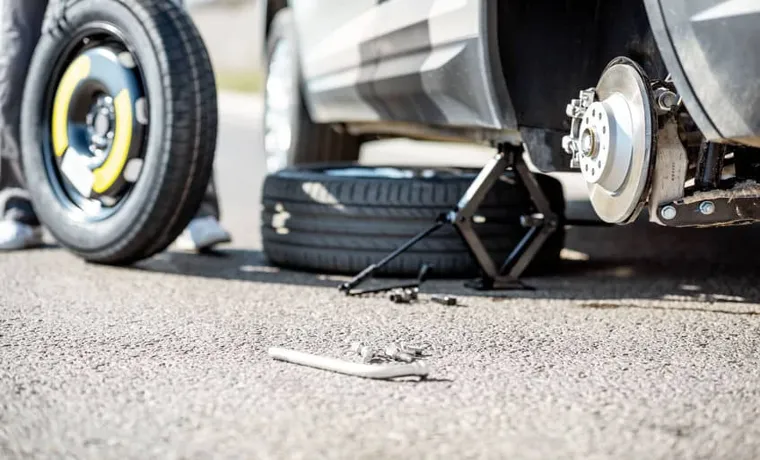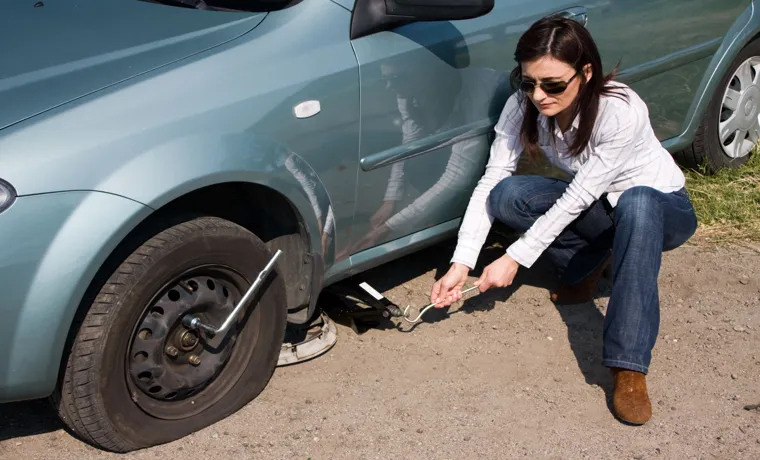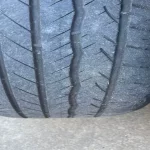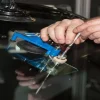Flat tires can happen at any time, and they always seem to catch us off guard. Waking up to a flat tire means having to deal with the issue before you can get back to your daily routine, and this can be frustrating, especially if you have no idea what to do next. Fortunately, with the right knowledge, dealing with a flat tire can be a simple process.
In this blog post, we’ll get you up to speed with everything you need to know about handling a flat tire with ease. From identifying the problem to changing the tire, we’ve got you covered. So if you’re looking to get back on the road as soon as possible, keep reading to learn more!
Table of Contents
Assessing the Situation
Getting a flat tire can be a frustrating experience, but it’s essential to stay calm and assess the situation. First, if you are driving, pull over to a safe spot on the side of the road. Make sure you are out of harm’s way and turn on your hazard lights.
Secondly, inspect the tire to see if it can be repaired using a tire repair kit. If the damage is too severe, then you’ll need to install the spare tire. Before installing the spare tire, make sure you read the car’s manual to understand the proper way to do it.
Keep in mind that a spare tire is a temporary solution and should not be used for a long time, so it’s best to take the car to a mechanic to get the tire replaced or repaired as soon as possible. If you don’t feel comfortable changing the tire, then don’t hesitate to call a tow truck or roadside assistance. Remember, it’s always better to be safe than sorry.
Pull over to a safe spot
When it comes to driving, we always need to be prepared for unexpected situations. One of the most crucial skills is assessing the situation and determining the appropriate course of action. If you find yourself in an emergency or unpredictable situation, the first thing to do is pull over to a safe spot.
Whether it’s a flat tire, mechanical failure, or a medical emergency, make sure to move your vehicle out of harm’s way. This may mean pulling onto the shoulder, exiting the highway, or finding a nearby parking lot. Once you’ve safely pulled over, assess the situation and determine the next steps.
This might involve calling for assistance, performing basic vehicle maintenance, or seeking medical attention. Remember, pulling over to a safe spot is the first and most important step in managing any unexpected situation on the road. Always prioritize your safety and the safety of others on the road.

Check the extent of the damage
When disaster strikes, it can be overwhelming to assess the extent of the damage. However, it’s important to take a deep breath and carefully evaluate the situation before taking any action. Start by looking around and taking note of any physical damage to your property or surrounding area.
Is there debris or fallen trees? Are there any visible cracks or structural damage? Once you’ve assessed the immediate physical damage, try to determine the scope of the impact. Has the disaster affected only your home or has it impacted the entire neighborhood? Depending on the severity of the situation, you may need to call for professional help or begin the process of filing an insurance claim. Remember to stay calm and take the necessary steps to ensure your safety and well-being.
In the end, assessing the situation may feel overwhelming, but taking the time to properly evaluate the extent of the damage will help to ensure a more successful recovery process.
Changing the Tire
Uh-oh, you just got a flat tire! Don’t worry, it happens to the best of us. The first thing you should do is pull your car over to a safe location, away from traffic. Once you’ve found a safe spot, turn off the car and engage the emergency brake to prevent any accidents.
Next, grab your spare tire, jack, and lug wrench from the trunk of your car. Loosen the lug nuts on the flat tire before using the jack to lift up the car until the tire is several inches off the ground. Then, use the lug wrench to fully remove the lug nuts and take off the flat tire.
Put the spare tire onto the wheel base and hand-tighten the lug nuts back onto the new tire. Finally, lower the car back onto the ground and use the lug wrench to tighten the lug nuts as much as possible. Don’t forget to check the tire pressure and get your flat tire repaired as soon as possible! That’s all there is to it – changing a tire might seem daunting, but with a bit of practice, it can be done in a jiffy.
Retrieve spare tire and jack
Before changing a tire, the first step is to retrieve the spare tire and jack from your vehicle’s trunk. It’s essential to know where your spare tire is located in your car before an emergency happens. The spare tire is usually located underneath the vehicle or in the trunk area.
Once you locate the spare tire, you need to grab the jack and lug wrench as well. Ensure that the jack is in good condition and that you read the instructions and safety precautions before using it. Additionally, make sure to park your car on a flat surface and turn on your hazard lights.
When changing tires, safety should always be a top priority to avoid accidents. Don’t forget to release the lug nuts before jacking up the car, and when the car is raised, remove the lug nuts and the flat tire and replace it with the spare time. After the spare tire is in place, tighten the lug nuts, lower the vehicle, and tighten the lug nuts again.
As long as you take these steps, you can successfully change a tire on your own without any additional help.
Loosen the lug nuts
When it comes to changing a tire, the first step is to loosen the lug nuts. This may seem like a no-brainer, but it’s important to remember that you need to do this before jacking up the car. It’s much easier to loosen them while the tire is still on the ground because the weight of the car will help keep it stable while you use the lug wrench.
To do this, simply place the wrench onto one of the lug nuts and turn it counterclockwise. If you’re having trouble getting it to budge, you can use your foot to apply pressure to the wrench handle. Just be careful not to slip or lose your balance.
Once you’ve loosened all the lug nuts, you can go ahead and jack up the car to remove the tire. Remember to keep the tire and lug nuts in a safe place so you don’t lose them! By taking these simple steps, you’ll be able to change a tire with ease and get back on the road in no time.
Jack up the car
If you find yourself with a flat tire, don’t panic, changing a tire is a relatively straightforward task. To begin, jack up the car. Locate the jacking points under the car, which are typically near the wheel.
Once you find them, position the jack under the car and crank it until the tire clears the ground. It’s essential to find a firm surface to place the jack on, like concrete or asphalt. Avoid uneven surfaces or loose dirt, as this can cause the car to tip over or the jack to sink.
Remember to tighten the jack periodically to ensure the car remains secure. With the car elevated, you’re now ready to remove the wheel and change the flat tire. Safety is key when changing a tire, so be sure to stay alert and aware of your surroundings.
Getting a flat tire isn’t ideal, but knowing how to change it can save you time and money in the long run.
Remove the lug nuts and tire
When it comes to changing a tire, one of the most important steps is the removal of the lug nuts. These little bolts are what keep your tire attached to the car, so it’s crucial that you remove them properly. Start by using a lug wrench to loosen each lug nut, making sure not to fully unscrew them yet.
Then, position your jack at the designated jack point underneath the car and raise the vehicle until the flat tire is about six inches off the ground. With the tire off the ground, go ahead and fully unscrew the lug nuts and remove the tire from the car. It’s important to keep in mind that lug nuts can often be very tight, so you may need to use some extra force in order to get them off.
Once the tire is off, inspect it for damage, wear, or any foreign objects that may have caused the flat. With the tire removed and inspected, you’re now ready to put on the spare or replacement tire and get back on the road. Remember, the proper removal and reinstallation of lug nuts is crucial for safe and successful tire changing.
Mount the spare tire
One of the most important things to know when changing a tire on your vehicle is how to mount the spare tire. After removing the flat tire, take the spare tire and align it with the wheel studs on the hub. Once aligned, push the tire firmly onto the studs and tighten the lug nuts as much as possible using a lug wrench in a diagonal pattern.
Be careful not to over-tighten the nuts, which could damage the studs or cause the tire to wobble. After tightening all the nuts, lower the vehicle to the ground and use the lug wrench to finish tightening the nuts. Remember, it’s always a good idea to check the tire pressure on your spare tire periodically to make sure it’s ready to go when you need it.
Tighten the lug nuts
When changing a tire, it’s important to remember to tighten the lug nuts properly. Failing to do so can result in a dangerous situation as the wheel could come loose while driving. After replacing the wheel and getting it onto the hub, use your hands to begin tightening the lug nuts.
Don’t use any tools until the nuts are hand-tightened as this will allow you to feel how much resistance there is and ensure that the wheel is secure. Then, use a wrench or tire iron to further tighten the lug nuts. Tighten each nut a little bit before moving on to the next one to ensure that the pressure is even.
It’s important to not over-tighten the nuts, as this can warp the brake rotor or strip the threads. If you’re unsure about whether or not the lug nuts are tightened properly, take the car to a mechanic and have them check it over. Taking the extra time to tighten the lug nuts properly will help keep you and your passengers safe on the road.
Getting Professional Help
Flat tires can happen at any time, and it’s good to be prepared with the right tools such as a tire jack, spare tire, and lug wrench. However, if you’re not comfortable changing a flat tire yourself or you don’t have the necessary tools, it’s best to seek professional help. Calling a roadside assistance service or a local auto repair shop can save you time and effort.
They can dispatch a professional who can change your tire quickly and safely, so you can be back on the road in no time. In addition, a professional can inspect your tire for any damage or wear and tear that may require a replacement. Remember, if you experience a flat tire while driving, safety should always be a top priority.
Pulling over to a safe location and seeking professional help is the best course of action.
Call roadside assistance
Sometimes, your car can break down or encounter problems while driving. When this happens, it is essential to get professional help immediately. The best way to do this is by calling roadside assistance.
They are experts who specialize in assisting drivers in difficult situations. They offer services such as jump-starting your car when the battery is dead, fixing flat tires, unlocking your car when you have locked yourself out, and towing your car when it cannot be repaired on the spot. You should have the contact information of roadside assistance at all times, so that you can call them whenever you need help.
Roadside assistance is your lifesaver in situations when you feel helpless or stranded. You do not have to worry about your safety, especially if you are on a busy road or an unfamiliar area. Roadside assistance professionals are equipped with the right tools and knowledge to fix your car and get you back on the road safely.
They respond promptly and efficiently to your distress call, which is a great relief for drivers. In conclusion, whether you are a seasoned driver or just starting, you should always be prepared for the unexpected when driving. One way to do this is by making sure you have the contact details of a reliable and professional roadside assistance provider like AARP or AAA.
By doing this, you can have peace of mind, knowing that help is just a phone call away in case of any emergency. So, keep the number of your local roadside assistance handy, and do not hesitate to call when you need expert help.
Take the tire to a professional for repair or replacement
When it comes to getting your tire repaired or replaced, it’s always best to take it to a professional. Sure, you could try to patch it up yourself or buy a new tire online, but that could end up causing more damage in the long run. A professional tire repair or replacement service will have the knowledge, tools, and experience to properly diagnose any issues and recommend the best course of action.
Plus, they’ll be able to ensure that your tire is mounted correctly and balanced, reducing your chances of experiencing any blowouts or flat tires down the road. So, don’t take any chances with your safety – take your tire to a pro.
Final Tips
If you ever find yourself with a flat tire, don’t worry – there are several things you can do to get back on the road. First, check your spare tire to ensure it’s in good condition. If you don’t have one, call a tow truck or roadside assistance.
Next, use a tire jack to raise your car off the ground and remove the flat tire. Make sure to position the jack correctly and securely before lifting the car. Then, use a lug wrench to loosen and remove the lug nuts, before carefully taking off the flat tire and replacing it with your spare.
Tighten the lug nuts, lower the car, and check the tire pressure before driving off. Remember, it’s important to drive slowly and carefully on your spare tire until you can get the flat tire repaired or replaced. And always be prepared by keeping a spare tire and tools in your car, just in case.
Check the pressure of the spare tire
When it comes to taking care of your vehicle, checking the pressure of your spare tire is often overlooked. However, this is an essential step that can save you a lot of hassle down the road. Your car’s spare tire is there for emergencies, and you don’t want to find out that it’s flat when you need it most.
To avoid this, make it a habit to check the spare tire’s pressure whenever you check your other tires. Most vehicles have a recommended pressure level of around 60 PSI for the spare tire, but it’s always best to check your car’s manual for the specific pressure required. So, the next time you check your tire pressure, don’t forget to give the spare tire some attention.
It may seem like a small detail, but it can make a big difference in an emergency situation. Keeping the spare tire at the proper pressure level will ensure that you have a safe ride home if you ever need to use it.
Get your damaged tire repaired or replaced as soon as possible
If you notice that one of your tires is damaged, it’s important to get it repaired or replaced as soon as possible. Not only can a damaged tire make your driving experience uncomfortable, but it can also be dangerous and increase your risk of getting into an accident. Whether you have a flat tire, a punctured sidewall, or any other type of damage, don’t delay in addressing the issue.
You may be tempted to keep driving on the tire, thinking you can make it to the shop or save money by waiting, but it’s not worth the risk. Take care of your vehicle and your safety by getting that tire fixed or replaced right away. Your wallet may thank you in the short term for waiting, but your safety and the longevity of your car will thank you in the long run.
Conclusion
When it comes to a flat tire, don’t panic – just remember to stay calm, find a safe place to pull over, and remember your trusty tools of the trade: spare tire, lug wrench, and jack. Remember, changing a tire may seem daunting, but with practice, you’ll become an expert at tackling this road hazard like a pro. Who knows, with your newfound tire-changing skills, you might even find yourself offering roadside assistance to other unfortunate drivers stranded on the side of the road.
So, when the rubber hits the road, just remember: keep calm, carry on, and change that tire like a boss.”
FAQs
What are the signs of a flat tire?
You may experience difficulty in steering, hear a thumping noise while driving, or notice one side of the vehicle is lower than the other.
Can I continue driving on a flat tire?
It is not recommended to continue driving on a flat tire as it can damage the rim and lead to costly repairs.
How can I prevent a flat tire?
Regularly checking tire pressure and tread, avoiding potholes and sharp objects, and rotating tires can help prevent a flat tire.
What should I do if I have a flat tire?
If possible, safely pull over to the side of the road and replace the flat tire with a spare. If you do not have a spare tire or are unable to safely change it yourself, contact roadside assistance.
How long can I drive on a spare tire?
Spare tires are designed for temporary use and should only be driven on for a short distance and at a reduced speed. 50 miles is the maximum distance suggested for driving on a spare tire.
Should I repair or replace a flat tire?
In general, if a tire has a puncture or damage to the sidewall, it should be replaced. If the damage is on the tread and is smaller than ¼ inch, it may be able to be repaired.
Can I prevent flat tires with tire sealant?
Tire sealant can be used as a temporary fix for smaller punctures, but should not be relied on as a permanent solution. Regular tire maintenance and inspection are still recommended.



